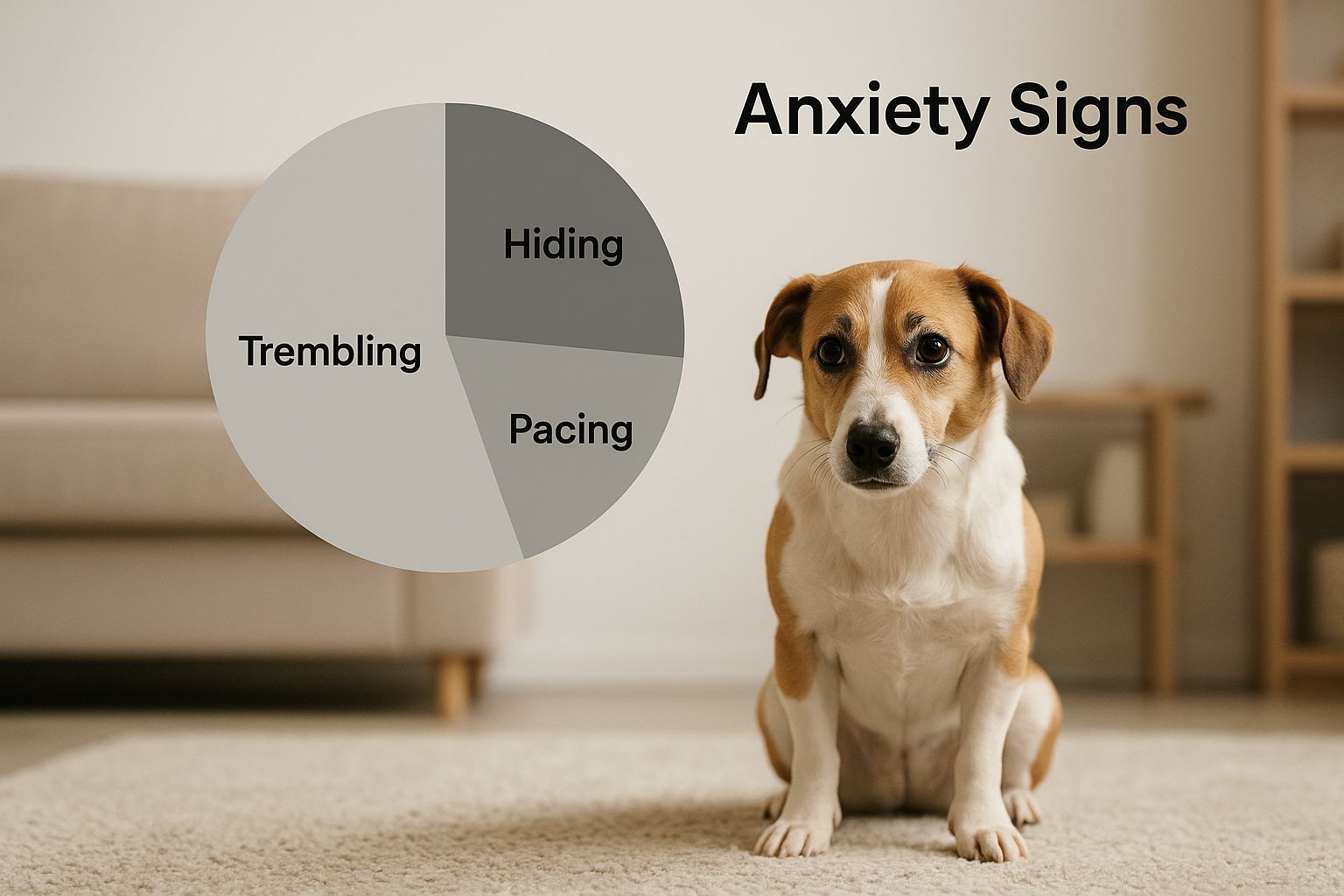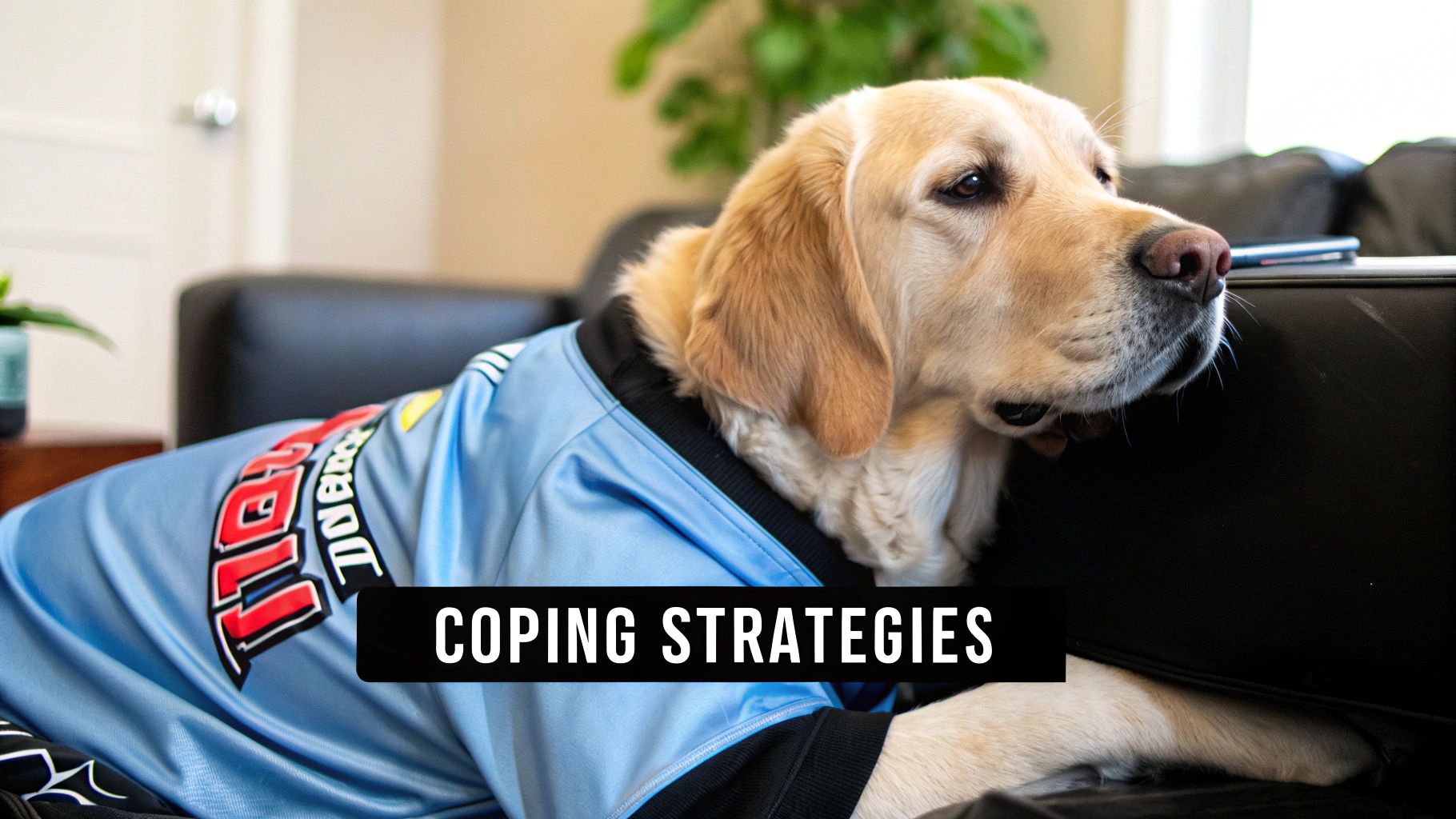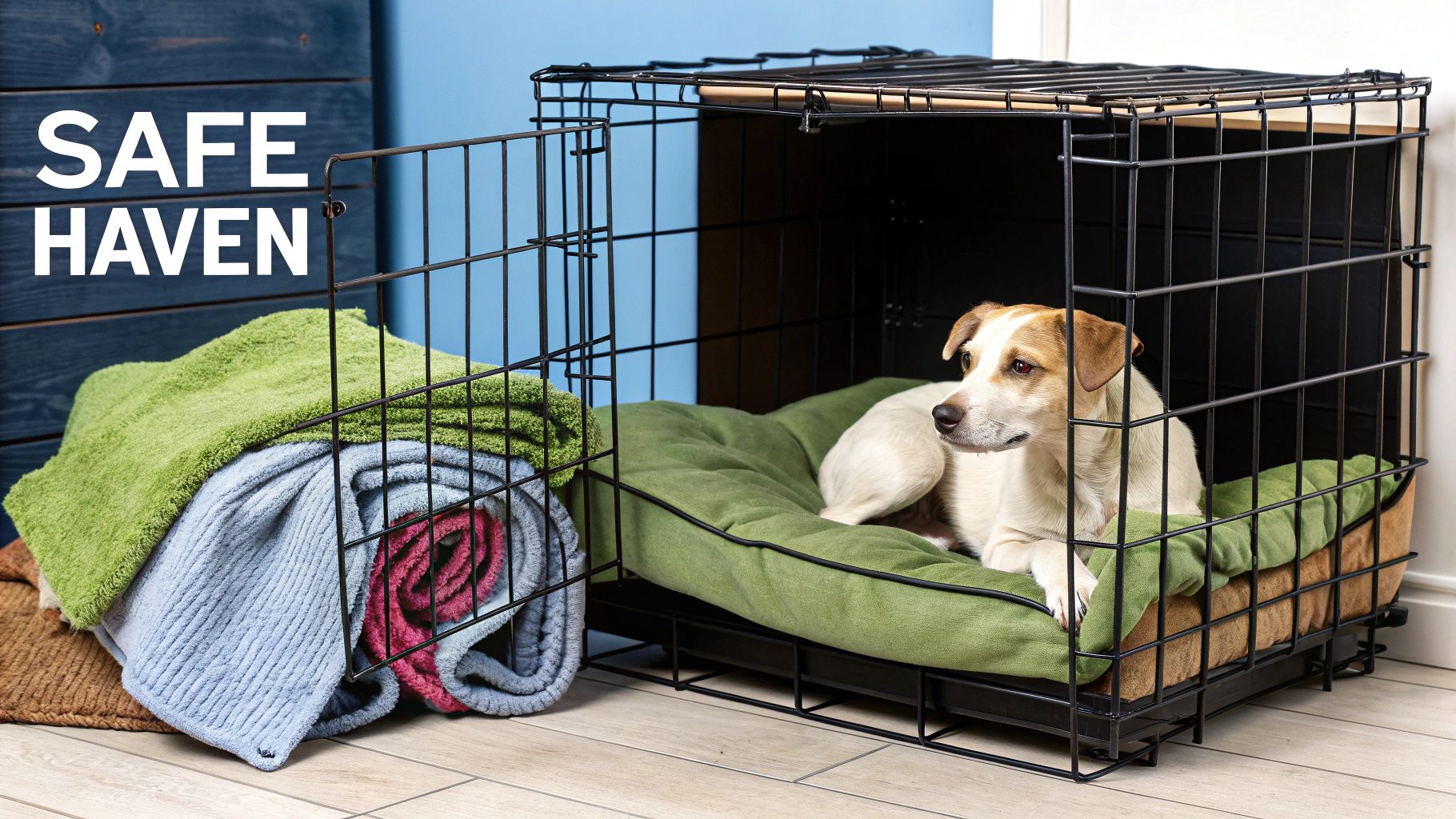When it comes to thunderstorm anxiety, we're not just talking about a dog being scared of a loud noise. It's a genuine, deep-seated phobia—a multi-sensory nightmare that can turn your happy-go-lucky companion into a trembling mess. This intense reaction is triggered by a whole cocktail of things: shifts in air pressure, the crackle of static electricity, and those deep, low-frequency rumbles that your dog can feel long before you can.
It’s a truly overwhelming experience for them.
Why Thunderstorms Terrify Your Dog
Watching your usually confident and playful dog completely transform as storm clouds gather is just heartbreaking. If you've seen this happen, you're certainly not alone. The first step to helping them is to understand why this happens. It isn't a simple fear; it's a full-blown phobia that takes over their senses.
Try to imagine it from their perspective. You're sitting in a room, and suddenly the air feels thick and heavy. Your hair starts to stand on end, and a deep, unsettling vibration hums through the floor. You can’t see what’s causing it, but every nerve in your body is screaming that something is wrong. This is what your dog feels long before the first clap of thunder. Their incredible senses, usually a superpower, become a source of intense dread during a storm.
A Full-Sensory Overload
Unlike us, dogs are wired to pick up on the smallest changes in their environment. They don't just hear the storm coming; they feel it in their bones. This sensory assault includes:
- Barometric Pressure Drops: Dogs can physically feel the drop in atmospheric pressure. For them, it’s an instinctual alarm bell signaling that danger is on the way.
- Static Electricity Buildup: That charge in the air can build up in a dog's fur, creating an incredibly uncomfortable sensation. It might even lead to tiny, startling shocks every time they touch something.
- Low-Frequency Rumbles: They can hear the deep, distant rumbles of thunder that are completely inaudible to us. Imagine hearing a constant, growing hum that you can't escape. It creates a pervasive sense of dread that just keeps building.
For many dogs, this isn't just one scary thing—it's a waterfall of frightening triggers. The pressure drop, the static on their fur, the inescapable sound... each one piles on top of the other, making the whole experience feel terrifying and impossible to escape. The anxiety they show is very similar to other common dog fears, and you can learn more about what causes them in our guide to understanding separation anxiety in dogs.
And this is a widespread problem. According to a massive study of over 13,700 pets, noise sensitivity is the most common anxiety-related issue, affecting around 32% of all dogs. With millions of us sharing our homes with canine companions, that means a huge number of dogs are suffering from these phobias. You can discover more insights about these findings on Nature.com.
Recognizing the Signs of Storm Anxiety
Ever feel like your dog is a furry little weather forecaster? If you've noticed them getting antsy long before you hear the first rumble of thunder, you're not imagining things. Many dogs pick up on subtle atmospheric changes, and recognizing their unique distress signals is the first, most crucial step in helping them through the storm.
Some signs are impossible to miss. Maybe your pup starts pacing endlessly, unable to settle down for a second. Or perhaps they become your shadow, clinging to your leg and whining for comfort. These are obvious cries for help.
But not all signs are so loud.
Physical and Behavioral Cues
The stress a dog feels during a storm triggers a very real, physical response—much like our own heart might pound when we’re scared. The real key is spotting behaviors that are completely out of character for your dog when the sky starts to darken.

As you can see, trembling is a classic indicator, but you should also keep an eye out for quieter cues. Things like excessive drooling or rapid, shallow panting when it's not even warm out are dead giveaways. These aren't choices; they're involuntary reactions as their nervous system goes into overdrive.
You might even see what looks like destructive behavior, but it's really just a desperate coping mechanism. For instance, a dog frantically clawing at the bathtub isn't trying to be naughty. They might be instinctively seeking a spot to ground themselves from the uncomfortable buildup of static electricity in their coat. Others will try to cram themselves into tiny, enclosed spaces—like a closet or under a desk—to feel safe.
A dog’s reaction to a storm is deeply instinctual. Their panting, hiding, or trembling isn't a choice—it's an overwhelming physical and emotional response to a perceived threat they cannot escape.
If these behaviors sound familiar, you might want to dive deeper. Our guide on the 8 key signs of dog anxiety to watch for can help you connect the dots and understand stress triggers that go beyond just storms.
To make things a bit easier, here’s a quick rundown of the common symptoms you might see when a storm is rolling in.
Common Symptoms of Canine Thunderstorm Anxiety
This table breaks down the most frequent behavioral and physical signs of storm-related stress.
| Symptom Category | Specific Signs to Watch For |
|---|---|
| Overt Behaviors | Pacing, frantic panting, whining, barking, or howling. |
| Seeking Comfort | Clinging to you, hiding under furniture, or trying to get into small spaces. |
| Physical Symptoms | Trembling, shaking, excessive drooling, and lip licking. |
| Escape Attempts | Scratching at doors or windows, digging, or trying to flee the house. |
Learning to read your dog’s body language is a game-changer. Once you can spot these signals early, you can step in and help turn a terrifying event into something much more manageable for your best friend.
The Science Behind Canine Storm Phobia
If you really want to help a dog who's terrified of storms, you first have to get inside their head. It’s so much more than just a fear of loud noises. For them, it’s a full-on sensory assault that starts way before you even hear the first rumble of thunder. Their incredible senses, which normally serve them so well, suddenly turn against them.
Try to imagine what it's like. You're in a room where the walls are humming with a vibration you can't hear but can definitely feel. The air itself seems to crackle with an invisible energy, and out of nowhere, there are blinding flashes of light. This is a little taste of what your dog experiences during a storm. They aren't just overreacting; they're responding to a barrage of triggers that we humans can't even perceive.
More Than Just a Loud Noise
That big "boom" of thunder? It’s usually the last straw. By the time it arrives, your dog's anxiety has probably been building for a while, thanks to a few key things changing in the environment.
- Barometric Pressure: Dogs are ridiculously good at sensing drops in atmospheric pressure. This shift is a dead giveaway that a storm is rolling in, and it triggers an instinctual warning bell that something isn't right.
- Low-Frequency Rumbles: Their hearing is on another level. Long before we hear anything, they can pick up on low-frequency rumbles from a storm that’s still miles away. To them, it's like a constant, approaching threat.
- Static Electricity: This is a huge one that most people miss. As the storm gets closer, static electricity builds up in the air. This charge can collect in your dog’s fur, creating an uncomfortable tingling sensation or even giving them little zaps when they touch something metal—or even you.
It's this combination of sensory overload that creates a perfect storm of anxiety. Your dog isn't just hearing a scary noise; they're feeling the world change around them in a deeply unsettling way, making it feel like there's no escape.
This sensitivity is no joke. A 2022 survey found that over 57% of dogs get anxious when they hear loud noises. While fireworks topped the list, thunder was a close second, affecting about 68.75% of those noise-sensitive pups. You can dig into more of these pet anxiety findings from Green Element.
Translating Their Discomfort
Ever wonder why your dog makes a beeline for the bathtub or a concrete basement floor? They might actually be trying to ground themselves from that static electricity. The ceramic or concrete can offer some relief from that awful zapping feeling in their fur. When you understand this, you see their behavior not as irrational fear, but as a smart attempt to find comfort.
Once we recognize these scientific triggers, we can move from just feeling sorry for them to actually doing something that helps. By understanding exactly what's causing their distress, we can find real solutions that tackle the root of their thunderstorm anxiety. Learning to connect these triggers with your dog's behavior is a game-changer, and our guide on how to read dog body language can help you get even better at it.
How to Create a Calming Safe Haven
When the sky gets dark and the rumbles start, your dog needs a place to go where they feel protected. Think of it as their own personal "thunder den"—a sanctuary you build for them long before the storm rolls in.
This isn't a time-out spot. It’s a fortress of calm, a predictable and secure retreat they can escape to on their own terms. The goal is to create such a positive vibe around this space that they choose to go there, turning fear into a feeling of comfort.

Choosing the Ideal Spot
Location is everything. You're looking for a spot that naturally muffles the sights and sounds of a storm. Where's the quietest, most insulated part of your house? That's your starting point.
Some of the best locations are:
- An interior closet: No windows and surrounded by other rooms means it’s great for blocking out sound and lightning flashes.
- A basement: Being underground is like having natural soundproofing. It’s perfect for muting those deep thunder rumbles.
- A windowless bathroom: The small, enclosed space can feel super secure, just like a real den.
Pay attention to where your dog already tries to hide when they're scared. That’s a huge clue. Steer clear of any areas with big windows or thin walls that put them on the front lines of the storm's sensory assault.
Stocking Your Sanctuary with Comfort
Once you’ve found the perfect spot, it’s time to deck it out. You want to fill it with things that bring both physical comfort and a sense of security.
A well-designed safe haven should engage your dog's sense of security. It's more than just a bed; it's a multi-sensory environment designed to counteract the sensory overload of a storm.
Start with something that smells like you—an old t-shirt or a blanket from the couch works wonders. Your scent is incredibly reassuring. Toss in their favorite chew toys to build a positive association with the space.
The centerpiece, of course, is a high-quality bed. We've put together a whole guide on finding the best calming dog beds for anxious pups that can help you pick the perfect one.
If the space has windows, think about adding blackout curtains or even noise-reducing shades to block flashes of light and muffle sound. A fan or a white noise machine is also a great addition. The steady, soothing hum can drown out the unpredictable booms and give your dog a peaceful auditory bubble.
Proven Techniques to Soothe Your Anxious Dog
Okay, so you’ve built a cozy storm shelter. That’s a fantastic start. But beyond just creating a safe space, you can actively work to manage your dog's anxiety in the moment and even help dial down their fear over time.
Think of it like helping a friend overcome a phobia. You wouldn’t just say, "get over it." You’d use a mix of gentle therapy and practical calming tools to build their confidence and change how they react. That's exactly what we're going to do for your dog.
Behavioral Modification Techniques
One of the most powerful long-term approaches is desensitization and counter-conditioning. It sounds like a mouthful, but the idea is actually pretty simple: you teach your dog to associate the scary thing (thunder) with something amazing.
Here’s the game plan:
- Find a Recording: Hop online and find some high-quality thunderstorm sound effects.
- Start Low: Play the sounds at a volume so low it’s barely audible. Your dog should be calm and relaxed.
- Bring the Good Stuff: The second the sound starts, give your dog a super high-value treat—think tiny pieces of chicken or their absolute favorite toy.
- Keep it Short & Sweet: After a few minutes, stop the sound and the treats at the same time. End on a positive note!
- Patience is Key: Over many sessions, you can slowly turn up the volume. If you see any sign of stress, you’ve pushed too far. Just dial it back to a level where they were comfortable and try again next time.
This process isn't a quick fix, but it gradually rewires their brain. Instead of thunder meaning "the world is ending," it starts to mean "chicken is coming!" For a deeper dive into this process, take a look at our complete guide to effective dog anxiety training.
The Power of Gentle Pressure
Another fantastic tool is an anxiety wrap or compression shirt. These work on a wonderfully simple principle: applying gentle, constant pressure to your dog’s torso. It’s the same logic behind swaddling a baby or getting a comforting hug. That steady pressure has a real, scientifically-backed calming effect on the nervous system.
The consistent pressure from an anxiety vest can help quiet an overstimulated nervous system. It provides a sense of security and physical reassurance that can significantly reduce the physical symptoms of panic, like trembling and panting.
And this isn't just wishful thinking; the research backs it up. One experimental study found that a whopping 89% of dog owners said these wraps were at least partly effective. Better yet, in a controlled test, anxious dogs wearing a similar vest during recorded thunderstorms showed a significant 8% decrease in their heart rate. That’s solid physiological proof that they work. You can read the full research about these anxiety wraps if you want to geek out on the science.
By combining long-term training with immediate comfort aids like an anxiety vest, you build a powerful strategy to help your dog feel safe and secure, no matter what the weather report says.
When to Seek Professional Help for Your Dog
While creating a safe space and trying at-home calming tricks can work wonders for a mild case of storm jitters, some dogs have a phobia that's just too big to handle on your own. Knowing when to call in the experts is one of the most important things you can do for your pet.
If you notice your dog's fear getting worse with every storm, that’s your cue to seek support.
Pay close attention to the red flags. Is your dog becoming destructive—clawing at the door, chewing up the couch, or desperately trying to escape? That's a clear signal their panic has become overwhelming. Another serious warning sign is any kind of self-harm, like licking or chewing themselves raw.
Consulting the Right Experts
When you realize you need backup, there are two key people to call:
- Your Veterinarian: Always start here. A vet can check for any hidden medical issues that might be making the anxiety worse. They're also your go-to for discussing safe and effective medication options if needed.
- A Certified Animal Behaviorist: Think of them as a therapist for your dog. These pros can design a custom behavior modification plan to get to the root of the phobia, often using gentle techniques like desensitization.
Asking for help isn't admitting defeat—it's being a responsible and loving dog owner. An expert can give you a clear, structured plan that will dramatically improve your dog's quality of life during scary weather.
When all the calming blankets and positive reinforcement in the world just aren't cutting it, your vet might bring up medication. To get a better handle on what that involves, it's worth reading up on medications for dog anxiety to understand what's possible.
Common Questions About Canine Storm Anxiety
When you're dealing with a dog who's terrified of storms, a million questions probably run through your head. You just want to do right by your best friend. Let's walk through some of the most common worries to get you on the right track.

A lot of people hope this fear is just a phase that will pass. I wish that were the case, but it's usually the opposite. Without our help, a dog's fear often gets worse with every storm, digging the phobia in deeper. This is exactly why stepping in early with a consistent plan makes all the difference.
Should I Comfort My Anxious Dog
This is the big one, and it's a real balancing act. Your heart tells you to scoop them up and smother them with love, but we have to be careful not to accidentally reward the panic.
It’s all about reassurance, not reinforcement.
- Reassurance: Being a calm, steady presence is everything. Gently stroking your dog or speaking in a low, even voice shows them you're there and you aren't scared.
- Reinforcement: Frantic petting, high-pitched "it's okay, you're okay!" chants, or giving special treats only when they're freaking out can send the wrong message. It can tell them, "Yes, this is the correct way to act right now!"
Think of yourself as the calm anchor in their emotional storm. You're not there to join the panic; you're there to show them the way out of it.
The single best thing you can do is model calm. Your dog takes cues directly from you. If you act like the storm is no big deal, it sends a powerful signal that there’s no real danger.
It’s easy to wonder if certain breeds are just wired for this. You do see a lot of noise sensitivity in herding dogs like Border Collies and German Shepherds. But the truth is, thunderstorm anxiety in dogs doesn't discriminate—it can pop up in any breed, any size, any mix. It’s far more about a dog’s individual personality and their life experiences than their family tree.
A supportive environment starts with the right foundation. Give your dog the ultimate safe space with a Flufer Store calming bed, designed to soothe anxiety and promote restful sleep when they need it most. Discover the perfect retreat for your best friend at https://fluferstore.com.













